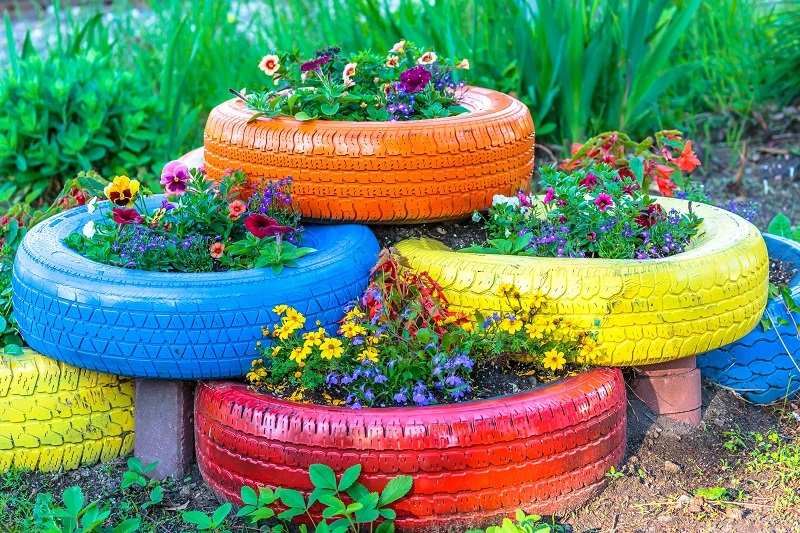Did You Know These 8 Amazing Facts About Sunflowers
Posted on 09/10/2025
Did You Know These 8 Amazing Facts About Sunflowers?
Sunflowers (Helianthus annuus) are more than just beautiful blooms that turn heads in gardens and fields. They have a rich history, unique biological features, and an incredible list of uses that go well beyond mere decoration. Whether you're a gardening enthusiast, a nature lover, or simply curious about the natural world, you'll find these 8 amazing facts about sunflowers both fascinating and informative.
1. Sunflowers Exhibit Heliotropism--They Follow the Sun!
Perhaps one of the most iconic sunflower facts is their remarkable ability to track the sun--a phenomenon known as heliotropism. Young sunflower plants orient themselves towards the east in the morning and slowly follow the sun's arc across the sky until sunset. This smart movement maximizes their light absorption, boosting their growth and energy production.
- Once the flowers mature, they typically settle facing east.
- This eastward orientation enhances early-morning pollinator visits by warming the blooms more quickly with sunrise.
- Heliotropism is controlled by specialized cells in the sunflowers' stems called pulvini.
Interesting sunflower fact: Older sunflowers lose this flexibility, but their younger, growing stages always put on a show by "following" the sun!

2. Sunflowers Are Native to North America
While many associate sunflowers with vibrant European fields or sophisticated oil production in Russia and Ukraine, the origin of sunflowers lies in North America. Native American tribes have cultivated these impressive plants for more than 4,500 years. In fact, sunflowers were one of the first crops domesticated in North America, much earlier than maize or even beans.
- Archaeological sites across the central and southwestern United States contain evidence of ancient sunflower cultivation.
- Sunflower seeds were ground into flour for cakes and bread or eaten as snacks, much like today.
- The vibrant yellow petals were used for dyes, while oils served as cooking ingredients and skin balms.
This ancient agricultural legacy makes the sunflower one of the most historically significant plants native to America.
3. Sunflowers Can Clean Up Toxic Soil
One extraordinary fact about sunflowers is their use in environmental cleanup efforts--a process called phytoremediation. Sunflowers have the ability to absorb and store harmful toxins, such as lead, arsenic, and uranium, from contaminated soils.
- Following the Chernobyl nuclear disaster in 1986, sunflowers were deployed to extract radioactive materials from the soil and water.
- The plants' deep roots make them ideal for drawing up pollutants that otherwise would persist in the ground for decades.
- This makes sunflowers a valuable resource in the ongoing battle against pollution and environmental degradation.
Did you know? Scientists are investigating using sunflowers at other contaminated sites worldwide, making these bright blooms not only beautiful but heroes of the environment!
4. The Tallest Sunflower on Record Reached Over 30 Feet!
When it comes to sunflower growth, these plants are true giants. The world record for the tallest sunflower goes to a jaw-dropping specimen that stood at 30 feet 1 inch (9.17 meters), grown by Hans-Peter Schiffer in Germany in 2014.
- Sunflowers can regularly grow between 6 and 10 feet, depending on the variety.
- Some specially cultivated "giant" sunflowers, favored in state and county fair competitions, are bred for their astonishing height.
- Proper soil nutrition and full sunlight are key ingredients for encouraging extraordinary sunflower growth.
Such towering sunflowers captivate onlookers and have firmly established these plants in the record books!
5. Sunflowers Are Actually Made Up of Thousands of Tiny Flowers
One of the most fascinating facts about sunflowers is that what most people think of as a single giant flower is actually a composite structure made up of thousands of smaller flowers. The sunflower "head," or capitulum, consists of:
- Ray florets: The striking yellow "petals" around the edge, which are sterile and serve to attract pollinators.
- Disc florets: The tiny, tubular flowers at the center, where seeds are produced after pollination.
Each disc floret has the ability to produce its own seed, which means a single sunflower can yield hundreds or even thousands of seeds if all florets are pollinated. This unique flower structure is shared among the Asteraceae family, including daisies and asters.
This intricate design isn't just beautiful--it's a brilliant adaptation for attracting pollinators and ensuring maximum seed production.
6. Sunflowers Play a Crucial Role in Agriculture and the Economy
The importance of sunflowers goes far beyond gardens and fields. They are a highly valuable agricultural crop and an economic powerhouse in many countries.
- Sunflower seeds are widely consumed as healthy snacks or ingredients in baking, cereals, and granola bars.
- The oil extracted from sunflower seeds is one of the world's most popular cooking oils, prized for its light flavor and high vitamin E content.
- Sunflowers feed livestock, generate birdseed, and are even used to produce biodiesel.
- The global sunflower oil market is worth billions of dollars annually, with top producers including Ukraine, Russia, and Argentina.
From salads to snacks and even energy solutions, sunflowers continue to sustain people and economies around the world.
7. Sunflowers Are an Artistic and Cultural Icon
Sunflowers have long captured the imagination of artists, writers, and cultures worldwide. Their vibrant color, towering height, and association with warmth and sunlight have inspired creative minds for centuries.
- Vincent van Gogh's famous "Sunflowers" paintings (1888-1889) are among the most recognized artworks globally, symbolizing happiness and optimism.
- Sunflowers are the state flower of Kansas, which is often nicknamed "The Sunflower State."
- In various cultures, sunflowers symbolize adoration, loyalty, and longevity.
- They commonly appear in Spanish festivals and folk art, emphasizing their role as a symbol of joy and abundance.
Few flowers have enjoyed such an enduring place in human history and art, with sunflowers representing positivity wherever they are celebrated.
8. Sunflowers' Mathematical Patterns: The Magical Fibonacci Sequence
One of the most incredible sunflower facts lies hidden in their structure. Look closely at a sunflower's face, and you'll notice the seeds arranged in a mesmerizing spiral pattern. This isn't just a random design--it follows the Fibonacci sequence, a mathematical pattern found throughout nature.
- Each seed is positioned at a specific angle known as the golden angle (approximately 137.5 degrees) from the previous seed.
- This arrangement allows the maximum number of seeds to fit in the least space, ensuring optimal sunlight and nutrients for each seed.
- Many plants, including pinecones and pineapples, use the Fibonacci sequence, but sunflowers are an especially beautiful example.
The symmetry and efficiency of sunflower seed patterns continue to astound botanists, mathematicians, and artists alike.
A Few More Fascinating Sunflower Facts
If you can't get enough of these striking plants, here are some bonus facts about sunflowers:
- Sunflowers are fast growers, able to shoot up several inches per week during peak growth periods.
- They come in a range of colors, including red, orange, and even white--though yellow remains the most common.
- There are more than 70 species in the Helianthus genus, with some grown primarily for ornamental purposes.
- Sunflower seeds are rich in healthy fats, protein, and minerals, making them a nutritious addition to your diet.
- Sunflowers are a crucial resource for pollinators, attracting bees, butterflies, and even hummingbirds with their nectar and pollen.

How Can You Grow Your Own Amazing Sunflowers?
Inspired by these unique facts about sunflowers? Fortunately, you can bring the magic of sunflowers to your own home with ease. Here are some quick tips for growing healthy and robust sunflowers:
- Choose a sunny location--sunflowers love full sun!
- Plant seeds directly in well-draining soil after the last frost date in your region.
- Water consistently, especially during dry periods, but avoid soil that becomes soggy.
- Tall varieties may require staking to support their impressive growth.
- Consider planting a mix of varieties for a burst of color and size in your garden.
With just a little care, your sunflowers will soon be turning heads and inspiring admiration from passersby and pollinators alike.
Conclusion: Sunflowers--Nature's Marvelous Giants
Sunflowers are so much more than meets the eye. From their sun-chasing stems and record-breaking heights to their critical roles in the environment, economy, history, and art, these eight amazing sunflower facts prove just how remarkable these blooms truly are. Their bright faces inspire hope, their seeds nourish, and their very presence in our world provides beauty and ecosystem benefits that should never be underestimated.
So the next time you spot a sunflower, remember: you're looking at a marvel of nature, science, and history all rolled into one radiant flower.
Frequently Asked Questions About Sunflowers
- What is the best season to plant sunflowers?
Late spring is ideal, after the risk of frost has passed and soil temperatures have warmed to at least 50?F (10?C). - Can sunflowers grow in pots?
Yes, dwarf varieties thrive in pots on patios or balconies, provided they receive plenty of sunshine and well-draining soil. - Are sunflower seeds safe for pets?
Plain, unsalted sunflower seeds are generally safe in moderation, but check first with your veterinarian, especially for pet birds and small mammals. - How long do sunflowers take to bloom?
Most sunflowers bloom in 70-100 days from planting, depending on variety and conditions.
For more fascinating articles on plants and nature, bookmark this page and come back soon!
Latest Posts
Did You Know These 8 Amazing Facts About Sunflowers
The Secret Meaning of Red Roses for Valentine's Day
See Which Blossom Aligns With Your Personality Vibes
Step-by-Step Guide for Making Poinsettias Last Until the New Year
Your Birth Flower Decoded: What It Means and How It Defines Your Essence






